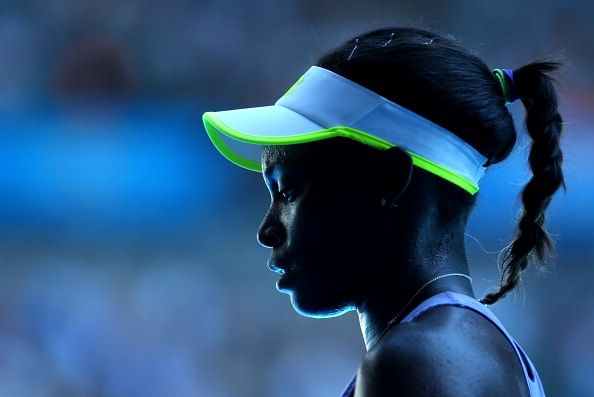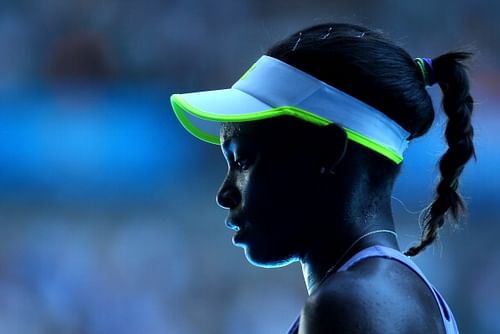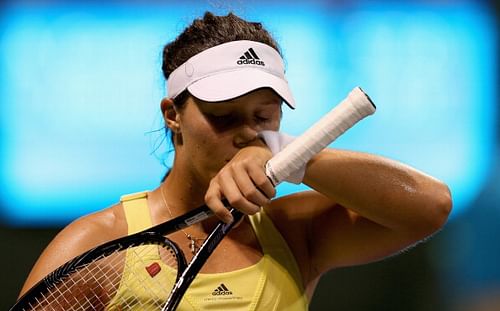
The burden of expectation on today's teenagers in tennis

Sloane Stephens looks on in her Semifinal of the Australian Open against Victoria Azarenka on January 24, 2013 in Melbourne, Australia. (Getty Images)
In March, American Sloane Stephens moved out of her teens and turned 20 years old. In the process, she handed over the baton of the highest ranked teenager in women’s tennis to Britain’s Laura Robson, who won’t turn 20 until next January.
The two have been at the forefront of a new young brigade invading the women’s game with 11 teenagers being ranked inside this week’s WTA Top 100 and have had an impressive rise over the past year. Robson was ranked no. 131 in the world last January and has risen to no. 38 after her first full season on the tour (players under 18 are restricted in the number of events they can play by the WTA) while Stephens has gone from no. 97 to no. 16 during that same period.
Both players have also had big successes at recent grand slams. Stephens reached the fourth round of the French Open last year and followed that up with third round finishes at Wimbledon and the US Open before making her big breakthrough in Melbourne. The then 19-year-old stunned Serena Williams in the quarter-finals in Melbourne to reach her first grand slam semi-final and before she knew it, Stephens was anointed the new ‘It’ girl in women’s tennis.
On the other hand, Robson upset Kim Clijsters and Li Na en route to reaching the fourth round at the US Open in September and also knocked off Petra Kvitova to reach the third round in Melbourne in January where she lost to Stephens. Robson’s performance in New York has inspired several of her peers as they step up on the WTA circuit.
Rising Canadian Eugenie Bouchard, a close friend of Robson’s, commented, “I’ve known Laura since we were nine, and when she made her run at the US Open, it showed hey, if she can do it, we can do it. When some of the young ones have runs like that, it definitely shows us all that they’re human, that all of these top stars are human and we can take them down.”
18-year-old American Madison Keys added, “We saw Laura do really well at the US Open last year, and she did really well in Australia, too. I think there’s a bunch of younger players right now that are starting to do well. They’re getting at least first round, second round, and sometimes third rounds. We’re kind of rooting for each other.”
Both Robson and Stephens have been marked out for success from their days in the juniors. Robson won the Wimbledon junior girls title as a 14-year-old while Stephens won three of four junior slam doubles titles as a 16-year-old. But with increasing success on the pro circuit comes increasing expectations and increasing pressure. And it’s a tough transition going from underdog to favourite.
Both Stephens and Robson have had their problems adjusting to life in the spotlight. Since Melbourne, Robson is only 2-6 on the tour, with 5 of those losses coming to players ranked below her. Stephens hasn’t fared much better, going 2-5 since Melbourne, with three of her losses coming to players ranked below her.
Stephens and Robson have both admitted that they have had problems with the increased attention and expectations. After losing in Dubai, Stephens commented, “I wish you guys would all just forget about me and just let me do whatever. That’s obviously not going to happen. I’m definitely working with you guys and hanging in there.” And in Miami, she told the media, “I mean, just a rough time. There’s not – there’s no specific thing that I’d say has happened or is not happening, but I don’t think it really matters. I’m [ranked No.] 16 in the world. I can lose in the first round the next two months and I probably would still be top 30. I’m not really too concerned about winning or losing or any of that, I don’t think. My life has changed, yeah, but I wouldn’t say I’m in a panic or anything.”
Stephens and Robson are not the first teenagers to make an impact on the WTA Tour. In fact, women’s tennis has always had a history of prodigious teenagers making big breakthroughs at grand slams. Martina Hingis was 16 when she won her first grand slam title and so was Monica Seles. Steffi Graf, Arantxa Sanchez-Vicario and Maria Sharapova also won their first grand slams as teenagers.
With the new WTA age-restriction rules, it’s unlikely that we are going to see a teenager rule the sport once again. But it does make you wonder why the pressure seems to exact a higher toll on today’s teenagers as compared to teens in the past.
Is the new generation of teenagers not equipped to handle the pressure of life in the spotlight? Maybe. Or perhaps and more likely is the fact that today’s teenagers are facing pressures and expectations that their predecessors did not face.
When Monica Seles and Jennifer Capriati made their big debuts as teens, the only place you would get read about them was in the newspapers or in sports magazines. The only place you would see them is on television during the major tournaments. And the players themselves would hear from their fans only via fan mail. And you would have had to be a big fan or an admirer to take the pain of writing a letter and posting it to a player. Very few fans would have taken the efforts to write a letter to a player to trash or criticize them.

Laura Robson looks dejected against Alize Cornet during their second round match at the Sony Open on March 22, 2013 in Key Biscayne, Florida. (Getty Images)
In today’s digital age, that paradigm has completely changed. For a tennis fan, it is easy to get all your tennis updates on the internet straight on to your computer or phone. You can catch a live stream of almost every professional tennis match played anywhere in the world. And with Facebook and Twitter, you can communicate with the players easily and instantaneously. You can send them messages of encouragement and just as easily trash them or abuse them for playing or behaving poorly.
And while the top players like Serena Williams or Rafael Nadal may have someone to filter through their messages on social networking sites, the young players, without the big prize money or endorsement dollars yet, are likely to do that themselves. Seeing a ton of foul messages just after you have lost a match that already hurts could have a major impact on a player’s psyche. That’s something that Graf, Seles and Hingis did not have to deal with.
Can you imagine the online backlash Seles would have got if Facebook and Twitter were around as she grunted her way to the top of the rankings? Or the type of comments Graf would have received when her father was involved in a paternity suit with a topless model. The outburst of criticism leveled against Victoria Azarenka for taking a medical time out in Melbourne was magnified due to the presence of Twitter and the internet. Hingis must surely be thanking her stars that these platforms weren’t available when she played Graf in that dramatic French Open final in 1999.
While the new digital world has made it very easy for fans to communicate with players, it has also made the players less isolated from the negativity while they are going through a rough patch. And sometimes isolation is just what they need.
Unfortunately for Stephens and Robson, they are the leaders of the first generation of players that are technology and social media savvy. The two have been often cited in the top 10 tennis players to follow on Twitter. The pressures and expectations are only going to increase as they rise towards the top 10. They will just have to bear the burden and hopefully, the two will lead by example for their peers once again.